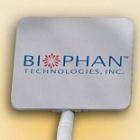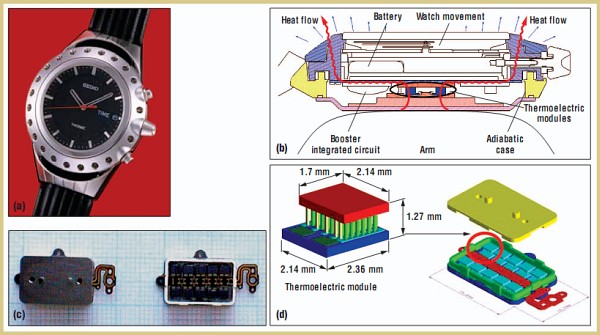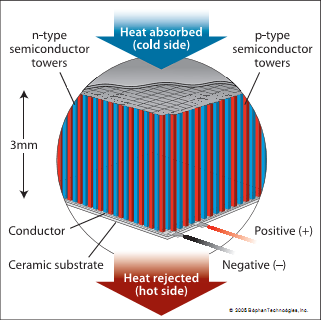
Toward Self-Powered Medical Implants
Roger Shih






| [ Introduction ] | [ Principle ] | [ Device Design ] |
Thermoelectrics
Introduction:
Scientists of the Fraunhofer Society, as well as the company Biophan, are exploring devices and semiconductor materials for the generation of electricity from small temperature gradients in the body. Up to 5 ºC of difference can be found across certain parts of the body, such as between the skin and the environment. As far back as 1998, the feasibility of scavenging power from this source was proven for non-biomedical applications by Japanese watch company Seiko, which introduced a "Thermic" wristwatch that ran on heat from the skin.
Principle:
These heat-powered devices take advantage of a phenomenon called the thermoelectric effect, or more specifically, the Seebeck effect. The basic functional unit is a thermocouple:

Where A and B are different materials, usually metals or semiconductors. The voltage generated by two temperatures T1 and T2 is given by:

In this expression, S is the thermopower of a material, with units V/K. It is a usually-nonlinear function of temperature that depends on the material’s crystal structure, particularly impurities and imperfections that disrupt heat conduction.
Conceptually, how is this voltage generated? The answer lies in energy-dependent charge-carrier scattering during heat conduction. When the two ends of a material are different temperatures, heat-carrying particles will diffuse from the higher end to the lower end, and cold-carrying particles will simultaneously do the opposite. Many of these particles will also be charge carriers, but no net charge is produced if the diffusion rate is equal in both directions. Fortunately, in many materials there is a difference between the diffusion rates of heat carriers and cold carriers, due to energy-dependent scattering. This capacity is represented by the aforementioned thermopower value, and encompasses the material’s impurities, imperfections, structural temperature dependence, and lattice vibrations. The result is a higher concentration of charge carriers on the end of the material that conducts heat slower, and a net voltage difference across the thermocouple.
Most thermoelectric-power devices in development use semiconductors instead of metals, since they can be modified to have unequal numbers of electrons and electron spaces. Whereas in metals the equal populations of electrons and spaces tend to cancel out each other’s induced voltages, in semiconductors the larger population will dominate over the smaller, and produce a greater net voltage. Currently, the best thermocouple materials have thermopowers of a few hundred μV/K. To generate more voltage, thermopiles consisting of multiple thermocouples in series can be assembled.
The theoretical limit for energy scavenging from a temperature difference is given by the Carnot efficiency:
(T1 – T2)/T1
Where T1 > T2, and both are in units of Kelvin. Regrettably, Paradiso and Starner have observed that the efficiency is quite low for small temperature differences, such as that between the body (37 ºC) and a cool room (20 ºC):
(273 + 37) – (273 + 20) / (273 + 37) = 17/310 = 5.48%
This makes thermoelectric power infeasible for more power-hungry applications, but it continues to be explored for less demanding implantable devices such as pacemakers and chemical monitors.
Device Design:
In the medical field, Biophan hopes to extend the
operating life of small implants by continuously recharging them with a
bismuth telluride semiconductor-based thermoelectric
energy-scavenger. Pacemakers, for example, might have their
lives extended from one decade to three by this method once the device
is perfected, and lower-power devices might even run
indefinitely. The company's goal is to produce a device that
will be able to generate 100 μW at 4 V in a slim package about 1 inch
squared, comparable in size to current Li-ion pacemaker batteries.


